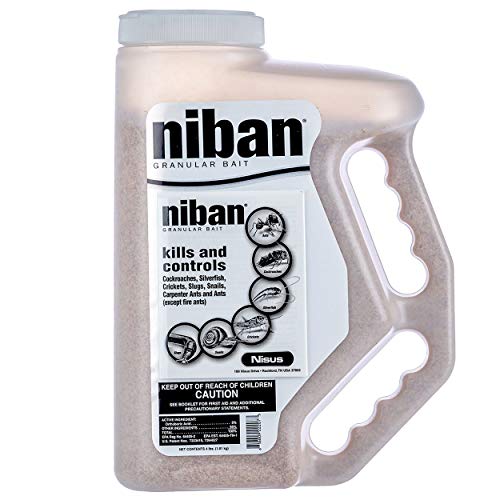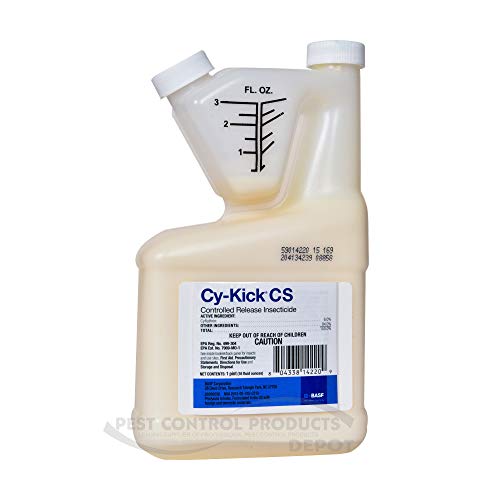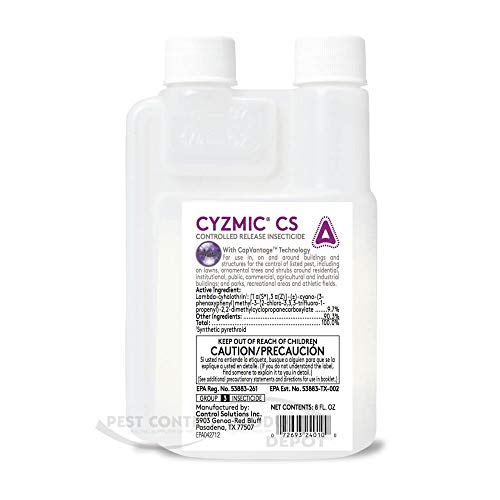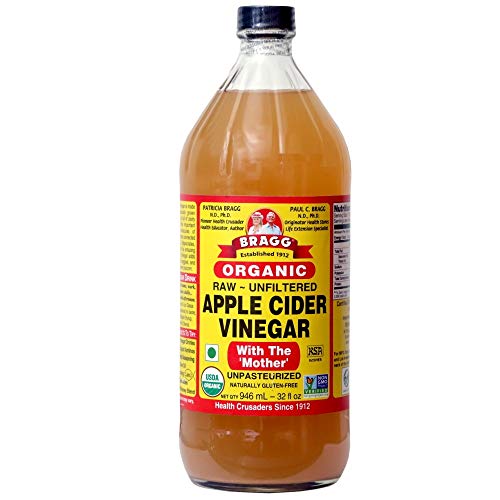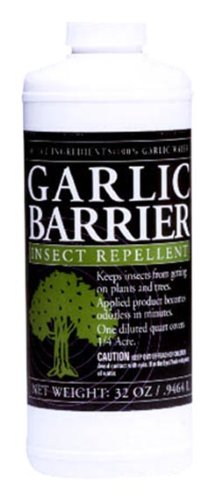How to get rid of grasshoppers: 10 way to kill grasshoppers for plants (Updated for 2023)
Let’s look into the best possible strategy to get rid of grasshoppers ahead of time using different practices.
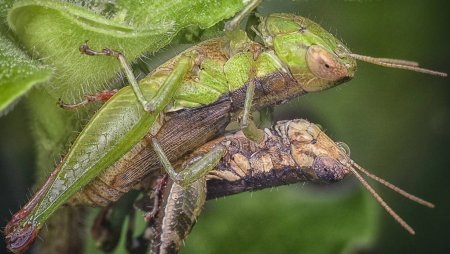
How to kill grasshoppers?
#1 Niban Granular Pest Control Insecticide Bait (Chemical – Editors’ Choice)
How to get rid of grasshoppers is no more a question if you can have this simple granular bait that contains 5% Boric Acid as its active ingredient. Its weather and moisture resistant properties help you a lot for staying it long if applied outdoors. It can be spread easily to create a band on the boundary of your garden and put into the crevices, cracks and crawling places of grasshoppers. After getting into the grasshopper’s stomach, it kills the microorganism in its stomach to block enzymes production that causes grasshoppers to starve eventually it stops feeding and loses its vigor to reproduce.1 cup of bait is sufficient to treat 100 square feet area in your garden. Keeping it away from the insecticidal spray will let the grasshoppers come to eat this bait.
#2 Semaspore Grasshopper Bait (Natural – Editors’ Choice)
Semaspore bait contains Nosema lacustae which is a naturally occurring disease in grasshoppers that keeps their population well in control if they are caught with that. This bait spreads disease in over 100 grasshopper’s species that harm the garden plants and crops in the field. After the bait is inside their stomach, they lose their ability to eat voraciously and also lose the ability to reproduce as the egg-laying is lowered to 80% and feeding reduces to 75%. Due to these reduced abilities, they start eating on the sick grasshoppers and their population decreases vigorously after 3-4 weeks of bait application. The process continues and grasshoppers keep on dying even in the next year. There is no side effect on humans, animals or beneficial insects in your garden.
Apply 1 ounce of bait in 500 square feet area when the grasshoppers are at an early stage in your garden. Doses can be increased on sudden or heavy infestation that may need a multiple application to keep grasshoppers off plants.
#3 Cy-Kick CS
Cy-Kick CS contains 6.0% Cyfluthrin that holds SmartCap technology to create a shell around the active ingredients to save it from weathering effects to release it in controlled doses for longer and to minimize its residual effects on the environment and humans. Using a technology that carries tiny mobile lethal doses of active ingredients to stick and move with the insect is harmful to the pest’s behaviors preparing to invade your plants. It will provide a prolong control on grasshoppers for 90 days with its broad-spectrum killing power. It can be used outdoors and indoors as well. It’s one application that would let you know how to keep grasshoppers off plants?
Add 2 ounces of Cy-Kick CS in one gallon of water in a mist sprayer and spray over the plants that are feared to be attacked by grasshoppers.
Spraying must be done in the evening that needs complete wetting of the plant’s upper foliage
#4 CYZMIC CS – Controlled Release Insecticide
CS stands for the controlled release of active ingredient Lambda Cyhalothrin 9.7% in Cyzmic. It’s a systemic insecticide and works exceptionally well against grasshoppers and other chewing insects in your garden. Systemic insecticides perform better when there is a sudden outburst of migratory pests or sudden changes in the climate that favors the invasion of such type of pests. It provides a longer control but can repeat after 15 days if the infestations are not significantly lowered after the 1st application. Giving 2-3 treatments during a season will kill and deter grasshoppers on your garden plants.
Mix 6ml of CYZMIC CS in 1 gallon of water in a power sprayer and wash your plants upside down thoroughly in the evening. Complementary watering is required after spraying any systemic insecticide in your garden that increases insecticide efficacy to kill resistant pests.
#5 Bonide-Neem Oil(70%) Insect Repellent
Neem oil works through 4 different ways to stop grasshoppers on your garden plants that are the reasons for its popularity among the organic gardeners who use it for their all edible plants. At first, Neem oil disrupts their lifecycle upon eating the leaves sprayed against, inhibits their feeding, deters them from egg-laying and retards their growth. You will be curious to listen to what kills grasshoppers on plants that Neem oil has. Azadirachtin holds all these properties that wouldn’t let grasshoppers freely feed in your garden space. Shake concentrated bottle well before mixing this concentrate into water. It performs well on all stages of insect development i.e. egg, larva, and adult that can be sprayed on edible plants till the time of harvest. No need to add any adjuvant into the mixture because there is fear to burn leaves.
Add 4 ounces of Bonide 70% Neem Oil in 1 gallon of water in a hand-held sprayer and spray on your plants thoroughly.
#6 Southern Ag Carbaryl 5 % Dust
How to kill grasshoppers instantly is no problem with this carbamate that contains 5% Carbaryl as its active ingredients. It can use on vegetables, ornamental plants, and grassy lawns for severe and sudden infestations of grasshoppers when no other remedy works well against them.
For Vegetables, use I pound in 1 gallon of water and spray using a pressure sprayer.
For Lawns, use 5 Pounds for 1000 square feet area.
For home Gardens, dust on the plants leaves thoroughly.
What are grasshoppers & where do they come from?
They are from the group of jumping insects in the order Orthoptera having more than 24000 species across the world out of which 1300 species have been identified that are supposed to exist in the US. They often occur in the greatest count in semiarid regions, lowland tropical areas and grasslands. Their color is variable from green to brown with yellow or red marks on the main body. Their sensory organs are located in different parts of the body like antennae at the head, cerci on the abdomen and receptors on the legs. Its taste organs are in the mouth while it smells with antennae. Tynpanal organ is used to hear while compound eyes are located on the forehead.
Damages:
What do grasshoppers eat is ultimately anything green that comes their way, they eat it up as they are herbivorous but only a few species are considered as crop pests due to their migratory habit. The short-horned grasshoppers are often more destructive, swarming and migratory and prominent species is the locust or Desert locust which have the history of devastating crops in the past.Their infestations are more common during the summer months in the tropical regions across the world while temperate regions are famous for their large sizes and chirping sounds they produce during the summer months
What eats Grasshoppers?
They are also eaten as food in some parts of the world where they are dried or often roasted especially in the Gulf and Africa. Other known predators are the birds including chicken, frogs, and snakes..
Grasshoppers’ life Cycle
Grasshoppers have only 3 life stages i.e. Egg, nymph, and adult and they go under an incomplete metamorphosis to carry on their reproduction to miss the caterpillar stage. They usually take 2 months to complete their life cycle from an egg to an adult. A female grasshopper lays eggs in the ground during the summer and fall. Eggs are given the shape of the pod in the soil. A pod contains 200 eggs as an average that again depends on the species of the female. The egg hatching takes place in 3-4 weeks whereas Nymph is passed in 8-10 weeks and adult 9-11 weeks depending on the ground temperature and species as well. Adult longevity of an adult is considered to be 51 days in males while a female does live for 52 days. How do long grasshoppers live can be supposed from the above findings that they may have 1 generation in a year in the temperate regions keeping in mind their natural predators.
How to prevent grasshoppers?
Preventing grasshoppers is only possible through traps and early sowing of the desired vegetables or greens. Early sowing is not possible because it is dependent on other factors like temperature and humidity where gardeners have already short spans to grow their edible stuff. On the other hand, traps can be used but once sudden outburst occurs, they go beyond control where the gardeners are left with the options to kill them with organic, natural and systemic insecticides for immediate control.
#7 Safer Brand-Insect Killing Soap
This insect-killing soap contains 2% Potassium salts of Fatty acid and is compatible with organic gardening. Seaweed extract is what lets your plants grow vigorously and allows beneficial insects to thrive in your garden. This unique formulation has a dual-action. On one side it dehydrates grasshoppers while on the other side it works on the health of plants allowing them to accelerate vegetative growth. It kills grasshoppers on contact leaving no side effects on the edible greens in a garden escape. It’s advisable to spray every 7-10 days as the product breaks down fully in the environment during this period and repetition is mandatory.
Its readymade formulation is simple and easy-to-use. Shake bottle well before any application.
#8 Bragg Organic Raw Apple Cider Vinegar
How to get rid of grasshoppers with vinegar applies two methods that are commonly used in the gardening landscapes. Both are fairly effective against all species of grasshoppers. Vinegar contains Acetic Acid that reacts with the skin of the grasshoppers and doesn’t let them molt. Molting is the process of shedding their skin before going into the next reproductive stage. When their process of molting stops, they stop feeding as well. An effective strategy is needed to kill grasshoppers while using vinegar.
- Mixing one part apple cider vinegar with 3 parts of water in a one-quart spray bottle would make an ideal solution to get rid of grasshoppers from your garden plants. Thoroughly spray all garden plants with this solution in the morning when their feeding is at peak. The same solution can be repeated keeping 2-3 days interval. Its organic remedy and there is no harm in using vinegar on your edible plants. There is no restriction to harvest after its immediate application.
- Take a plastic container having the 1-quart liquid capacity and bury it into the garden soil. Fill this container with pure apple cider vinegar leaving 1 inch empty from the top. Add 1 teaspoon of vegetable oil and agitate for a while. Grasshoppers will keep coming in & keep dying. If someone escapes from the solution, they will not able to feed on plants again.
#9 Insect Repellent Garlic Barrier
This repellent has garlic concentrate that contains allicin which is a strong deterrent along with killing properties. It prepares from special garlic variety called Super garlic that possess more strength of allicin. It works well on a wide range of insects including grasshoppers, spider mites and aphids. It’s an organic listed product that can be repeated after 14 days of its first application.
Shake contents of the bottle well before making a solution. Always spray organic products in the morning that is deterrent as well as a killer. Add 2.5 ounces in one gallon of water. Agitate well and spray on the entire vegetation using a hand-held pressure sprayer.
#10 Entomophthora Grylli
Entomophthora Grylli is a fungi strain that infects grasshoppers to paralyze them. On infestations, they hang on stems or parts of the plants tightly and die in this position. Fungi grow and perform well in the hot & humid weather where grasshoppers’ infestations are more common. But sadly, it’s not available commercially yet.
Some working Entomologists may help you to hold a sample of the fungi to test in your environment.

